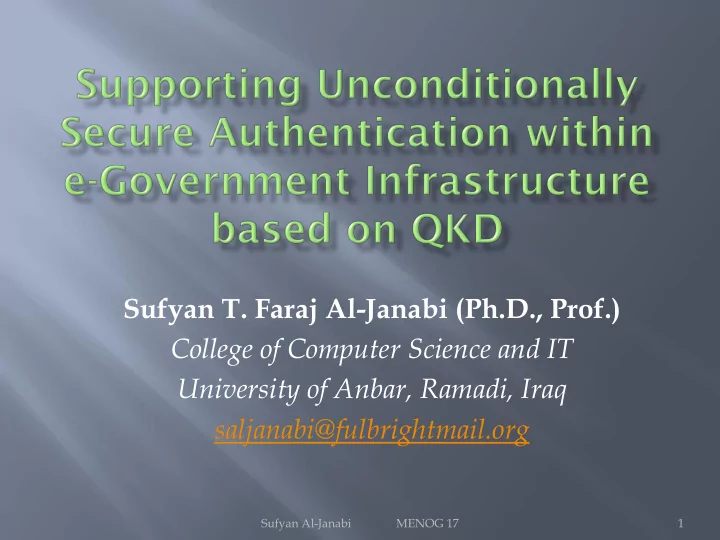

Sufyan T. Faraj Al-Janabi (Ph.D., Prof.) College of Computer Science and IT University of Anbar, Ramadi, Iraq saljanabi@fulbrightmail.org Sufyan Al-Janabi MENOG 17 1
Problem Statement & Work Objective Authentication Issues The Proposed Framework Architecture QKD Networks QSSL Protocol Implementation & Obstacles Conclusions & Future Work Sufyan Al-Janabi MENOG 17 2
It has been noticed that the speed of ICT advancement in developing, deploying, and using e-government infrastructures is much faster than the development and deployment of security services. Therefore, government organizations are still suffering from the existence and emerging of security risks. All available security solutions are only computationally-secure! Sufyan Al-Janabi MENOG 17 3
The aim of this work is to show the importance and validation of including unconditionally- secure authentication services within e- government infrastructure based on QKD. The work highlights the basic requirements for a general framework that facilitates such inclusion and also introduces sample protocol modification. Sufyan Al-Janabi MENOG 17 4
Message Authentication Codes (MACs) Mathematical Authentication A-Codes Techniques Digital Signatures Sufyan Al-Janabi MENOG 17 5
MACs and A-codes can provide data integrity and data origin authentication. It is important to emphasize that MACs are only proven to be computationally secure while the security of A-codes is unconditional. Thus, MACs are suitable for short-term security but they are not useful for long-term (say 20 years) requirements, especially when considering new technologies like quantum computers. Sufyan Al-Janabi MENOG 17 6
Digital signatures are very widely used technology for ensuring unforgeability and non-repudiation of information. Digital signature schemes can be constructed for both computational security and unconditional security. Sufyan Al-Janabi MENOG 17 7
eGMMs ISMMs A-Codes, etc.. General Convergence Maturity Model Sufyan Al-Janabi MENOG 17 8
Sufyan Al-Janabi MENOG 17 9
Signature- Signature- Info-box creation verification access Session Session Session certificates encryption decryption Key- synchronization Sufyan Al-Janabi MENOG 17 10
Sufyan Al-Janabi MENOG 17 11
Quantum Hybrid PKI- Courier-based cryptographic- based approach: based approach: approach: • Recently, there • Properly • This is the most have been combining traditional significant QKD with approach advancements in public-key Quantum Key based Distribution authentication (QKD) Sufyan Al-Janabi MENOG 17 12
QC delivers cryptographic keys whose secrecy is guaranteed by the laws of physics. QC offers new methods of secure communications that are not threatened even by the power of quantum computers. In quantum cryptography, physically secure quantum key distribution can be combined with the mathematical security of the OTP cipher and/or information-theoretically secure authentication (based on universal hashing) . Sufyan Al-Janabi MENOG 17 13
Sufyan Al-Janabi MENOG 17 14
Sufyan Al-Janabi MENOG 17 15
Sufyan Al-Janabi MENOG 17 16
Sufyan Al-Janabi MENOG 17 17
Tightly-coupled protocol stack strategy; secret random bits obtained from QKD (which is mainly a physical layer technology) are merged directly somehow into a conventional higher-layer security protocol suite. Thus, the consumer security protocol has to be modified to enable the integration of QKD within it. Loosely-coupled protocol stack strategy; the focus here is to develop original multi-layer protocol infrastructures that are dedicated to QKD networks. In such a case, the QKD network infrastructure can be viewed as a "new cryptographic primitive“. Sufyan Al-Janabi MENOG 17 18
19 Sufyan Al-Janabi MENOG 17
Sufyan Al-Janabi MENOG 17 20
Using A-codes can offer additional security benefits especially in situations when long-term and/or significantly high level of security is required. We advise A-codes based services for G2G and G2B settings only in the first adaptation stage. It is possible in next stages to include e- democracy (especially e-voting) Sufyan Al-Janabi MENOG 17 21
Since our current implementation is mainly limited to simulation. Future work might consider prototype implementation on Intranet level. Further investigation of hardware and software requirements of such systems for wired and/or wireless settings can also be considered. Sufyan Al-Janabi MENOG 17 22
Sufyan Al-Janabi MENOG 17 23
Recommend
More recommend